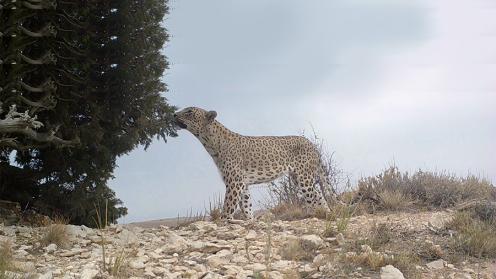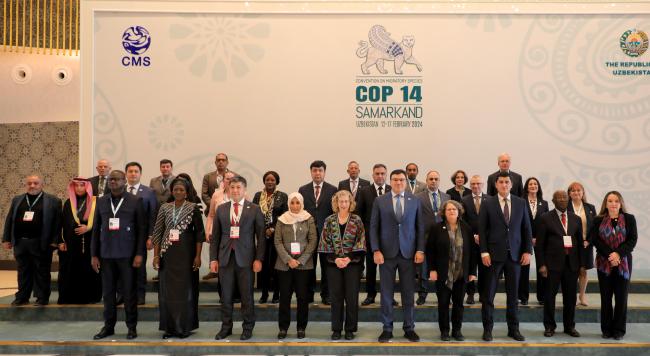Expressing their commitment to transboundary cooperation to ensure the conservation of migratory species, ministers gathered for a special High-level Segment under the theme “Nature Knows No Borders: Working together for migratory species and sustainable development in Central Asia.”
Welcoming everyone to Samarkand for the 14th Meeting of the Conference of the Parties of the Convention on Migratory Species of Wild Animals (CMS COP 14), Aziz Abdukhakimov, Minister of Ecology, Environmental Protection and Climate Change, Uzbekistan, said one in five CMS listed species are threatened with extinction and 44% are undergoing population declines. He pointed to habitat loss, degradation, and fragmentation as the most significant threats to migratory species and their habitats. Abdukhakimov stressed that actions under CMS are crucial for ensuring the global commitments set out in the Kunming-Montreal Global Biodiversity Framework (GBF), including ecological connectivity and networks of protected areas.
CMS Executive Secretary Amy Fraenkel said regional cooperation in Central Asia has been essential for many species, including the Snow Leopard, Saiga antelope, and the Bukhara deer. She announced the CMS will launch the first-ever State of the World’s Migratory Species on Monday, 12 February. She anticipated this report will provide the scientific basis for policy decisions to ensure migratory species do not only survive but thrive.
Inger Andersen, Executive Director, UN Environment Programme (UNEP), said we cannot protect migratory species without multilateralism, and we must work harder, faster, and smarter with a united front. She called on participants to look beyond the jurisdiction of environment ministries and environmental treaties to have a whole of society and whole of world approach.
Session 1. Transboundary and Regional Cooperation for the Conservation of Migratory Species in Central Asia
Sherzod Umarov, Assistant Food and Agriculture Organization (FAO) Representative in Uzbekistan, moderated a discussion among the following Central Asian officials: Melis Turgunbaev, Minister of Natural Resources, Ecology, and Technical Supervision, Kyrgyzstan; Bakhodur Sheralizoda, Chair, Committee for Environmental Protection under the Government, Tajikistan; Aziz Abdukhakimov, Minister of Ecology, Environmental Protection and Climate Change, Uzbekistan; Nurken Sharbiyev, Deputy Minister of Ecology and Natural Resources, Kazakhstan; Begench Miminov, Deputy Minister of Environmental Protection, Turkmenistan; and Yerlan Nyssanbayev, Minister of Ecology and Natural Resources, Kazakhstan.
The ministers highlighted that Central Asian countries were responsible for UN General Assembly Resolution 75/271, Nature knows no borders: transboundary cooperation – a key factor for biodiversity conservation, restoration, and sustainable use. They recalled it represents the first time the General Assembly has recognized the importance of transboundary habitats and transborder cooperation. They described the growth of transboundary protected areas for the region’s critical migratory routes, flyways, and breeding grounds.
They also highlighted the importance of:
- cooperation of all countries and all sectors of society for preserving biodiversity;
- preventing infrastructure development, including roads, rail, and renewable energy facilities, from destroying and fragmenting critical habitat;
- creating ecological corridors;
- educating and training the next generation of environmental experts and scientists; and
- collaboration with NGOs, the Convention on Biological Diversity (CBD), CMS, and the International Union for Conservation of Nature (IUCN).
Session 2. Multilateral linkages with cooperation in Central Asia
In a video address, former UN Secretary-General Ban Ki-moon, current President of the Assembly and Chair of the Global Green Growth Institute, cautioned that we run the risk of more zoonotic diseases as we continue to exploit wildlife and encroach on habitat. Fighting climate change and protecting the environment are urgent challenges that require all hands on deck, he added.
The second dialogue session featured: David Cooper, Acting Executive Secretary, CBD; Musonda Mumba, Secretary General, Ramsar Convention on Wetlands; Consuelo Vidal, UN Resident Coordinator a.i. in Uzbekistan; Grethel Aguilar, Director General, IUCN; and Valerie Hickey, Global Director, Environment, Natural Resources and Blue Economy, World Bank.
Participants noted:
- the Saiga antelope has recovered because Central Asian wetlands are healthy, but wetlands are vanishing faster than forests;
- the need to address the tragedy of the Aral Sea and the loss of crucial habitats for migratory birds and other wildlife;
- the value of building on linkages between CMS and the CBD;
- the opportunities presented by the GBF Fund recently established under the Global Environment Facility (GEF);
- the contributions of IUCN’s activities and cooperation in Central Asia; and
- the relevance of the World Bank’s programmes in Central Asia that focus on protected areas and harmonizing priorities, delivering on renewable energy infrastructure without harming nature, and investing in better pandemic responses, including early warning and medical readiness.
They also stressed the importance of public awareness, research, and increased funding from domestic public budgets and the private sector.
Session 3. Experiences from other Regions and Multilateral Entities on Transboundary and International Cooperation for the Conservation of Migratory Species of Wild Animals
In this session, ministers and other high-level officials shared experiences with transboundary and international cooperation for the conservation of migratory species.
Viriato Luís Soares Cassamá Minister for the Environment, Biodiversity and Climate Action, Guinea Bissau, said over 26% of national land is in protected areas, and highlighted efforts to conserve sea turtles, migratory birds, and large mammals. Lalya Ali Camara, Minister of Environment, Mauritania, shared cooperative efforts to protect the Mediterranean Monk Seal.
Tom R. Butime, Minister of Tourism, Wildlife and Antiquities, Uganda, discussed efforts in East Africa to protect Mountain Gorillas. Ali Abosenna CEO, Egyptian Environmental Affairs Agency, said Egypt is investing in renewable energy while incorporating measures to protect migratory birds. Kumara Wakjira, Director General, Ethiopian Wildlife Conservation Authority, discussed initiatives with neighboring countries to establish transboundary landscape management to protect species including flamingo, the African elephant, and the African wild ass.
Bettina Hoffmann, Parliamentary State Secretary of the Federal Minister for the Environment, Nature Conservation, Nuclear Safety and Consumer Protection, Germany, noted protected areas now cover 18% of the EU, which is the largest coordinated cross-border network of protected areas in the world. Moïse Rasamoelina Secretary General of the Ministry of the Environment and Sustainable Development, Madagascar, noted conservation efforts in 125 protected areas spread over 7 million hectares that protect 108 migratory species, including Dugong, sea turtles, migratory birds of prey, and rays, sharks, and whales.
Ernesto D. Adobo, Jr., Undersecretary of the Department of Environment and Natural Resources, Philippines, discussed efforts to protect sea turtles and reduce illegal harvesting of turtle eggs, as well as related work of the Coral Triangle Initiative. Shaikha Salem Al Dhaheri, Secretary General, Environmental Agency Abu-Dhabi, United Arab Emirates, described efforts to reintroduce over 625,000 Houbara Bustard and hundreds of Arabian oryx, and the support provided by the Mohamed bin Zayed Species Conservation Fund to conserve more than 1,500 endangered species across 160 countries. Aurélia Bouchez, French Ambassador to Uzbekistan, called for universalization of the CMS and reported the Government of France will provide EUR 200,000 to CMS and will double bilateral contributions to biodiversity to reach EUR 1 billion by 2025.
Daniel Gustafson, Special Representative of the Director General, FAO, discussed the interlinkages between health, wildlife and people and noted Central Asia is at the cutting edge of cooperative innovation. Martha Rojas Urrego, Executive Secretary, International Whaling Commission (IWC), noted many of the major threats faced by cetaceans require international cooperation and highlighted the IWC’s conservation management plans, and collaboration with CMS and other environmental agreements.
Rodney Jackson, Founder/Director Snow Leopard Conservancy, said 40% of the Snow Leopard population is found within 100 km of an international border and, like other wild creatures, know no boundaries. He added the most impactful interventions are empowering local communities and drawing on traditional knowledge. Koustubh Sharma, International Coordinator, Global Snow Leopard Ecosystems Protection Program, noted climate change and habitat destruction cannot be looked at in silos and said environment ministers in Central Asia have agreed to work on these issues and mobilize resources to bridge funding gaps.
In his closing remarks, Minister Abdukhakimov thanked everyone for participating and called for turning commitments into actions.
Signing Ceremonies
During the High-level Segment, the following four signing ceremonies took place:
- Kyrgyzstan, Kazakhstan, and Uzbekistan signed the Memorandum of Understanding on the Conservation of Migratory Birds of Prey in Africa and Eurasia.
- Kazakhstan and Uzbekistan signed the Memorandum for Cooperation on Conservation of Wildlife on Ustyurt Plateau.
- CMS and the Environmental Agency Abu-Dhabi signed the donor agreement for hosting the CMS Office - Abu Dhabi.
- Uzbekistan, FAO, and IUCN signed the agreement for the Food System, Land Use and Restoration Impact Program, under the GEF.
To receive free coverage of global environmental events delivered to your inbox, subscribe to the ENB Update newsletter.


